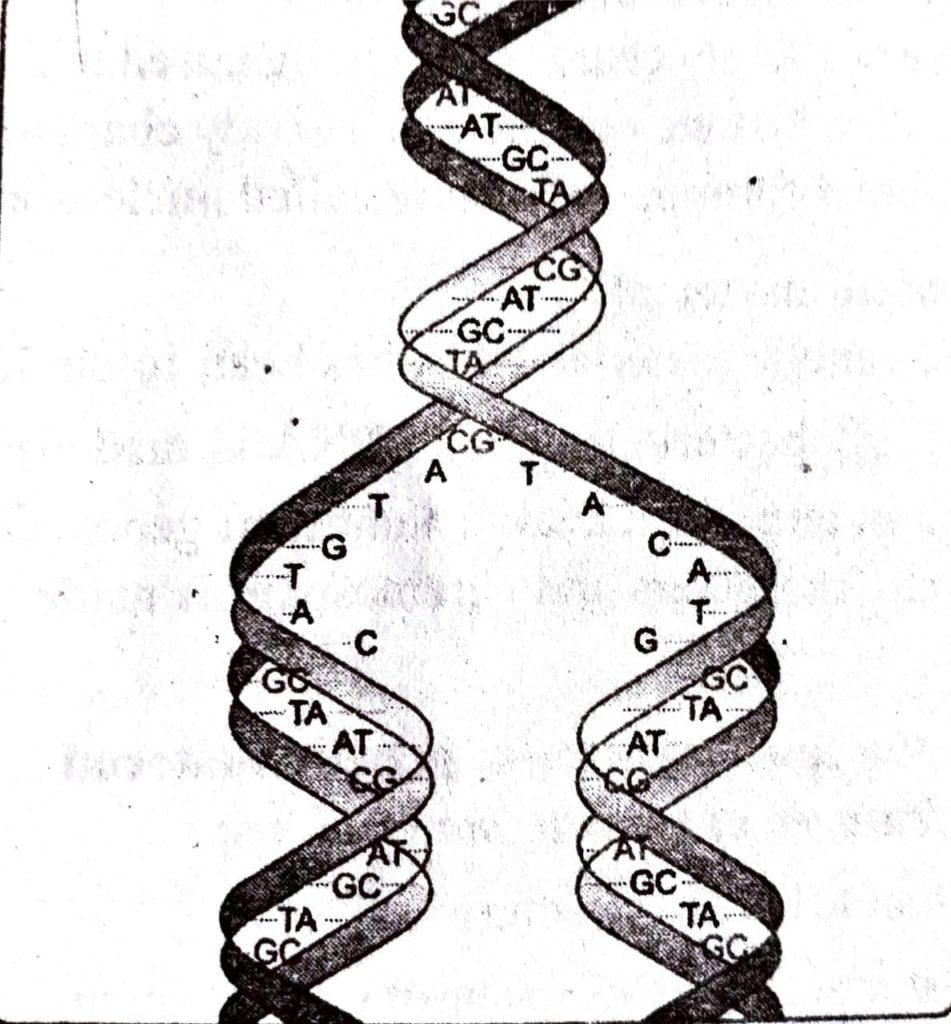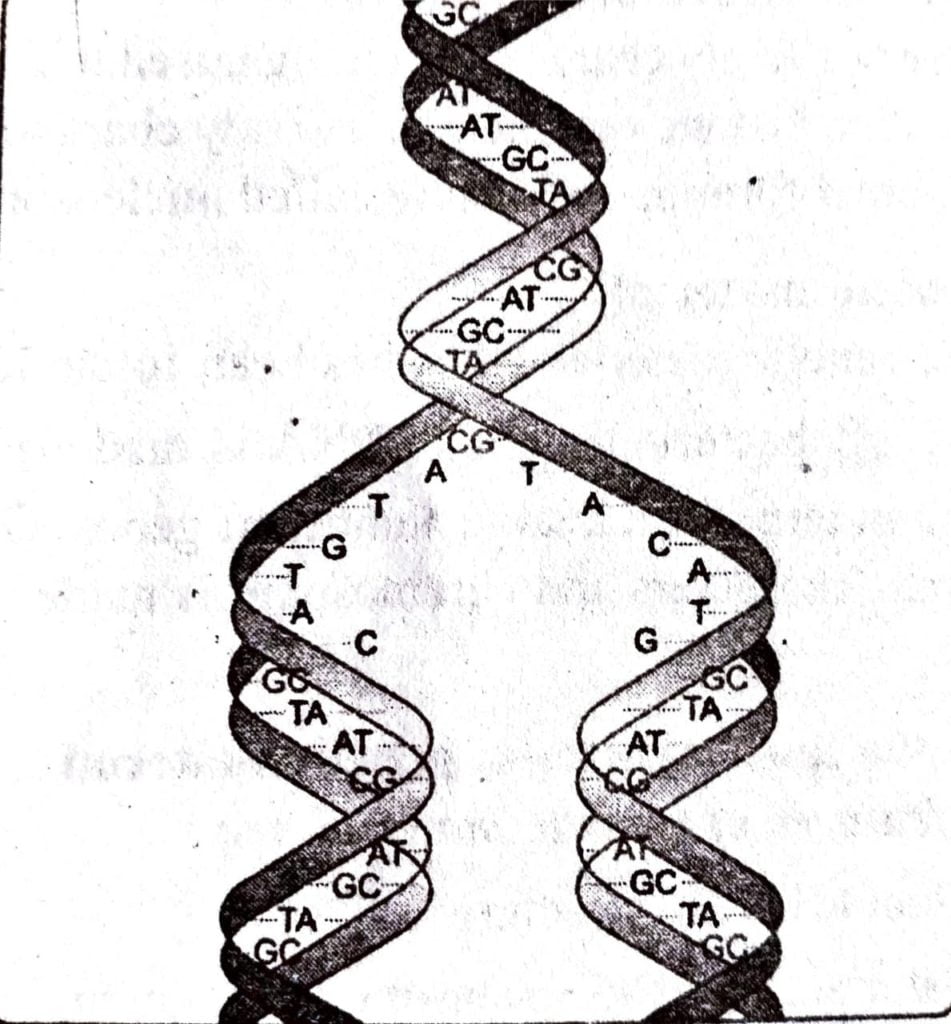Class 12 Biology Chapter 6 Molecular Basis of Inheritance The answer to each chapter is provided in the list so that you can easily browse through different chapters Assam Board HS 2nd Year Biology Chapter 6 Molecular Basis of Inheritance Question Answer.
Class 12 Biology Chapter 6 Molecular Basis of Inheritance
Also, you can read the SCERT book online in these sections Solutions by Expert Teachers as per SCERT (CBSE) Book guidelines. These solutions are part of SCERT All Subject Solutions. Here we have given Assam Board Class 12 Biology Chapter 6 Molecular Basis of Inheritance Solutions for All Subjects, You can practice these here.
(D). Short Answer questions (2 marks) :
Q.1. Who coined the term genetic code? What does it mean?
Ans : Marshall W. Nirenberg and J. Heinrich Malhaei coined the term genetic code.
Codon is the triplet of bases that code for a particular amino acid.
Q.2. Discuss the structure of nucleosome.
Ans : Histones are positively charged which organised to form a unit of eight molecular called histone octamer. Negatively charged DNA wrap twice over the october forming a structure called nucleosome.
Q.3. Define genetic material.
Ans : DNA is the genetic material. RNA has been found to be genetic material in TMV, θβ bacteriophage etc. DNA is made of a series of nucleotides which in term form a large number of genes. Genes are the bearer of hereditary characters and chromosome is made up of highly coiled DNA.
Q.4. What are the four features of genetic material?
Ans : The four features of genetic material are :
(i) DNA is a double helical structure.
(ii) Genetic materials have the power of replication to form duplicate of it.
(iii) Stability of genetic material should be existed.
(iv) Genetic material should be able to undergo mutation and such a e change should be stably inherited.
Q.5. How does DNA express its biological information.
Ans : During protein synthesis mRNA copy the information coded in DNA these information to ribosome where protein is synthesized as par the coded information collected from the DNA.
Q.6. Where and when replication does occur?
Ans : DNA replication takes place inside the nucleus to form duplicate copy of parent DNA. Replication occurs when the cell is ready for division so that each daughter cell receives exact copy of parent DNA.
Q.7. Why DNA replication is stated to be semi-discontinuous?
Ans : Waston and Crick suggested a simple mechanism of replication on the basis of its double helical structure. The method of DNA replication is described as semiconservative method because daughter DNA molecule is a hybrid conserving one parental polynucleotide chain and forming the second one.

Q.8. How is the translation of mRNA terminated?
Ans : In the process of formation of poly nucleotide chain in ribosome amino acids are joined end to end and the process continues till three nonsense codons (UUU, UGA, UGA) present in the mRNA are encountered. On reaching the termination codon (nonsense codon) the polypeptide chain is released from ribosome.
Q.9. What is transcription?
Ans : DNA transfers its information to mRNA which moves to the ribosomes to direct protein synthesis. The formation of RNA from DNA template is called transcription. It occurs during the interphase.
Q.10. Name the transcriptional units in DNA.
Ans: Cistron is the unit of transcription. One cistron carries the information of a polypeptide.
Q.11. What are exons?
Ans : DNA codes for mRNA but complete sequence of DNA is not found in mRNA. The sequences of DNA found in mRNA are known as exons. The coding sequences in eukaryotic genes are called as exons.
Q.12. Why hnRNA is required to undergo splicing.
Ans : The eukaryotic genes are.interrupted by non coding DNA segments. The intervening sequences are known as introns. They are absent in RNA. The eukaryotic cells here, transcribes a precursor RNA much longer than mRNA. This is called heterogeneous nuclear RNA (hnRNA). It undergoes shortening by looping out mechanism to relegate unwanted nucleotide sequences. Process is called as RNA splicing. After this molecule undergoes polyadenylation, capping and methylation at 5′ and so that to form the mRNA molecule. The mRNA molecule then moves to cytoplasm as free nucleoprotein complex (informosomes).
Q.13. What is a satellite DNA?
Ans : It has been reported that heterochromatin contains certain polygenes to transcribe rRNA (in the NOR) 5S RNA and tRNA. Its DNA is formed of repeated polynucleotide sequences (about 100 to 100 million times) each being formed about 300 nucleotides and is called satellite DNA or repetitive or redundant DNA. The genes in heterochromatic region perhaps become active for a short period.
Q.14. “The genetic code is degenerate.” Explain.
Ans : The genetic code degenerate. For a particular amino acid more than one codon can be used. One amino acid often has more than one code triplet eg. phenylalanine has two codons, ie uuu and uuc. Argine has six codons CGU, CGC, CGA, CGG AGA, AGG All Codon started with AC (ACU, ACC, ACA, ACG) specify theanine and with CU (CUU, CUC, CUA, CUG) specify leucine. It helps avoid error.
(E). Short Answer Question (3 Marks) :
Q.1. Draw the structure of tRNA.
Ans :

Q.2. Describe the transformation experiment of Griffith. What was his conclusion?
Ans : In 1928, Frederick Griffith, in a series of experiments with Streptococcus pneumoniae witnessed a miraculous transformation in the bacteria. During the course of his experiment, a living organism (bacteria) had changed in physical form. When streptococcus pneumoniae bacteria are grown on a culture plate, some produce smooth shiny colonies (s) while others produce rough colonies (R). This is because the S strain bacteria have a mucous coat, while R strain doesn’t. Mice infected with the S-strain (virulent) die from pneumonia infection but mice infected with the R strain do not develop pneumonia.
S strain → Inject into mice → Mice die
R strain → Inject into mice → Mice alive
Griffith was able to kill bacteria by heating them. He observed that heat killed S strain bacteria injected into mice did not kill them. When he injected a mixture of heat killed and live R bacteria, the mice died. Moreover, he recovered living S-bacteria from. che dead mice.
S strain → Inject into mice → Mice live (heat killed)
S strain
(heat killed)
+ → Injected into mice → Mice die
R strain
(live)
Griffith concluded that the R strain bacteria had some how been transformed by the heat-killed S-strain bacteria. Some transforming principle, transferred from the heat killed S strain, had enabled the R strain to synthesise a smooth polysaccharide coat and become virulent. This must be due to the transfer of the genetic material. However, the biochemical nature of genetic material was not defined from his experiments.
Q.3. Write a note on biochemical characterization of transforming principle of Griffith.
Ans : In 1944, sixteen years after Griffith’s experiment, Ostuarald Avery, Colin Macleod and Maclyn Mccarty reported successfully repetition of bacterial transformation, but in vitro. They were able to identify the transforming genetic material. They worked to determine the biochemical nature of ‘transforming principle’ in Griffith’s experiment.
They purified biochemicals (proteins, DNA, RNA etc) from the heat killed S cells to see which one could transform live R cells into S cells. They discovered that DNA alone from S bacteria caused R bacteria to become transformed. They also discovered that protein digesting enzymes like Proteases and RNA digesting enzymes like RNA ases did not affect transformation. So the transforming substance was not a protein or RNA. Digestion with DNAse didn’t inhibit transformation, suggesting that the DNA caused the transformation. They concluded that DNA is the hereditary material, but not all biologists were convinced.
Q.4. Write there differences between DNA and RNA.
Ans : The three differences between DNA and RNA are :
| DNA | RNA | ||
| (i) | The sugar is Deoxyribose. | (i) | The sugar is ribose. |
| (ii) | The nitrogenous bases are A, G C and T. | (ii) | The nitrogenous bases are A, G C and U. |
| (iii) | DNA is double stranded structure. | (iii) | RNA is single stranded structure. |
Q.5. Briefly discuss the process of DNA replication.
Ans : While proposing the double helical structure of DNA, Watson and Crick had immediately proposed a scheme for replication of DNA. The scheme suggested that the two strands would separate and act as a template for the synthesis of new complementary strands. After the completion of replication, each DNA molecule would have one parental and one newly synthesised strand. This scheme was termed as semiconservative DNA replication.

Q.6. How did Hershey and Chase proved that DNA is the genetic material?
Ans : Alfred Hershey and Martha Chase in 1952 worked with viruses that infect bacteria called bacteriophages.
The bacteriophage attaches to the bacteria and its genetic material then enters the bacterial cell. The bacterial cell treats the viral genetic material as if it was its own and subsequently manufactures more virus particles. They worked to discover whether it was protein or DNA from the viruses that entered the bacteria.
They grew some viruses on a medium that contained radioactive phosphorous and some others on medium that contained radioactive sulphur. Viruses grown in the presence of radioactive phosphorous contained radioactive DNA but not radioactive protein because DNA contains phosphorus but protein does not. Similarly, viruses grown on radioactive sulphur contained radioactive protein but not radioactive DNA because DNA does not contain sulphur.
Radioactive phages were allowed to infect to E. coli bacteria. Then as the infection proceeded, the viral coats were removed from the bacteria by agitating them in a blender. The virus particles were separated from the bacteria by spinning them in a centrifuge.
Bacteria which was infected with viruses that had radioactive DNA were radioactive, indicating that DNA was the material that passed from the virus to the bacteria. Bacteria that were infected with viruses that had radioactive proteins were not radioactive. This indicates that proteins didn’t enter the bacteria from the viruses. DNA is therefore the genetic material that is passed from virus to bacteria.

Q.7. How is protein synthesis initiated in a cell?
Ans : The process of synthesis of proteins involves one of the central dogma in molecular biology. According to this, genetic information flows from nucleic acids to protein. We know that DNA is stable inherited from parents to offsprings. According to central dogma, the flow of information takes place from DNA to RNA (mRNA) and from RNA to protein. This can be illustrated as follows:

Q.8. Draw labeled schematic sketch of replication fork of DNA.
Ans :

Q.9. Write three goals of Human Genome Project.
Ans : The three goals of Human genome project are:
(a) 95% of gene containing part of human sequence finished to 99.99% accuracy.
(b) To laraliza and estimate all the genes within the human genome.
(c) To construct detailed genetic map of human genome.

Hi, I’m Dev Kirtonia, Founder & CEO of Dev Library. A website that provides all SCERT, NCERT 3 to 12, and BA, B.com, B.Sc, and Computer Science with Post Graduate Notes & Suggestions, Novel, eBooks, Biography, Quotes, Study Materials, and more.


